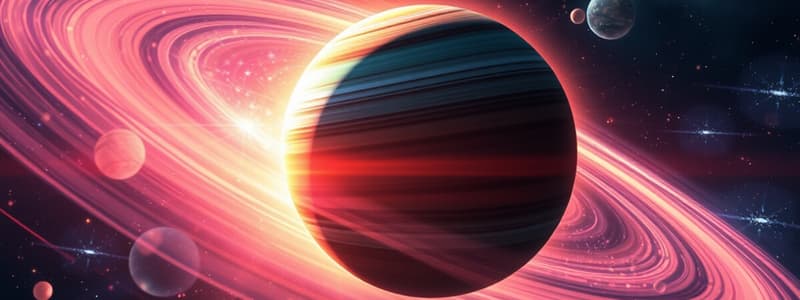Podcast
Questions and Answers
How does the magnitude of the gravitational force exerted by Planet Y on its satellite compare to the gravitational force exerted by Planet X on its satellite?
How does the magnitude of the gravitational force exerted by Planet Y on its satellite compare to the gravitational force exerted by Planet X on its satellite?
- FY = 3 FX
- FY = FX
- FY = 1/3 FX
- FY = 3/4 FX (correct)
How does the gravitational field gX at the surface of Planet X compare with the gravitational field gY at the surface of Planet Y?
How does the gravitational field gX at the surface of Planet X compare with the gravitational field gY at the surface of Planet Y?
- gX = gY
- gX = 1/3 gY
- gX = 3gY (correct)
- gX = 4gY
What direction does gravity act on a moon in orbit at the indicated position?
What direction does gravity act on a moon in orbit at the indicated position?
Right
What is the gravitational force exerted on the moon while it is in orbit around the planet?
What is the gravitational force exerted on the moon while it is in orbit around the planet?
What supports the observation that a moon's orbit is not perfectly circular or elliptical?
What supports the observation that a moon's orbit is not perfectly circular or elliptical?
What is the new gravitational force exerted on one container by the other after the mass is altered?
What is the new gravitational force exerted on one container by the other after the mass is altered?
What is the centripetal acceleration of the second satellite in terms of the first satellite's acceleration?
What is the centripetal acceleration of the second satellite in terms of the first satellite's acceleration?
Which measuring devices are essential for determining an object's gravitational and inertial mass?
Which measuring devices are essential for determining an object's gravitational and inertial mass?
Which experiment could be used to determine the gravitational mass of the object?
Which experiment could be used to determine the gravitational mass of the object?
What does the student claim about the motion of a planet as it orbits a star?
What does the student claim about the motion of a planet as it orbits a star?
Study Notes
Gravitational Forces Between Planets
- The gravitational force exerted by Planet Y on its satellite is ( F_Y = \frac{3}{4} F_X ), where ( F_X ) is the force from Planet X.
- Planet X has mass ( M ) and radius ( R ); Planet Y has mass ( 3M ) and radius ( 3R ).
- The gravitational force diminishes with increasing distance from a planet's center.
Gravitational Fields of Planets
- The gravitational field ( g_X ) at the surface of Planet X is ( g_X = 3g_Y ), with ( g_Y ) being the field at Planet Y's surface.
- Gravitational field strength is influenced by mass and radius.
Orbital Dynamics of Moons
- In free-body diagrams for a moon in a circular orbit, gravity acts toward the planet.
- Gravitational force on a moon with mass ( 1 \times 10^{22} ) kg and gravitational field strength ( 0.001 ) N/kg results in a force of ( 1 \times 10^{19} ) N while in orbit.
Non-Circular Orbits
- Observations of moons reveal that deviations from circular or elliptical orbits can indicate the influence of another celestial body exerting gravitational force on the moon.
Gravitational Force Between Two Containers
- When Container A's mass increases to ( 1.5M ) and Container B's decreases to ( 0.5M ), the new gravitational force is ( \frac{3}{4}F_0 ), with ( F_0 ) being the initial force between them.
Centripetal Acceleration in Satellites
- For satellites orbiting a planet, if Satellite A has centripetal acceleration ( a_0 ) and Satellite B is at double the distance ( 2d ), then its centripetal acceleration is ( a_b = \frac{a_0}{4} ).
Measuring Gravitational and Inertial Mass
- To determine gravitational mass, a student can use a spring scale and measure the weight of an object hanging at rest.
- To find inertial mass, the same object can be pulled with a constant force on a surface, using a spring scale and measuring devices like a meterstick and timer.
Experimental Methods for Mass Calculation
- Experiment 1, where weight is measured using an electronic balance, is capable of determining the gravitational mass of the object.
- Experiment 2, which involves pulling the object across a surface, can only contribute to determining inertial mass under constant force conditions.
Studying That Suits You
Use AI to generate personalized quizzes and flashcards to suit your learning preferences.
Description
This quiz explores the concepts of gravitational forces, fields, and orbital dynamics between planets and their moons. It covers the mathematical relationships of gravitational forces and the impact of mass and radius on gravitational fields. Test your understanding of both circular and non-circular orbits with this interactive quiz.




